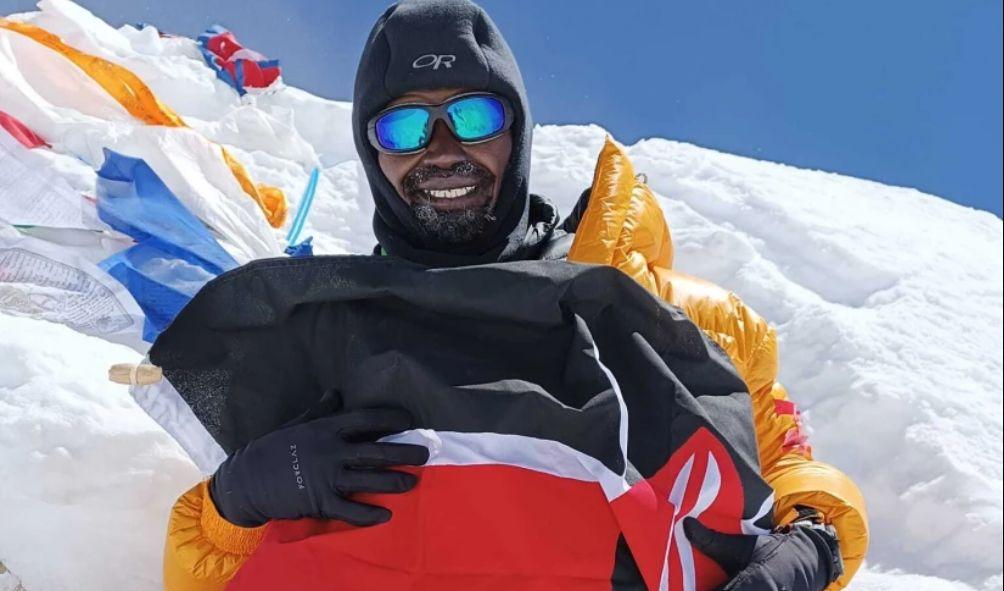Five Conditions Cheruiyot Kirui Gave His Guide Before Tragic Mt Everest Climb
Kenyan climber Cheruiyot Kirui’s aspiration to reach the summit of Mount Everest came to a tragic end this week as he passed away just meters from the top of the world’s tallest peak.
Kirui, who worked as a banker for KCB, aimed to climb Everest, which stands at 8,848.86 meters, without the aid of supplementary oxygen.
On Wednesday, Kirui and his guide, Nepali climber Nawang Sherpa, went missing at Bishop Rock, situated at an altitude of 8,000 meters.
The discovery of Kirui’s body was reported on Thursday morning by the Nepali mountaineering news outlet Everest Today. The whereabouts of Sherpa are still unknown.
At extreme altitudes, Everest is almost uninhabitable without supplementary oxygen, which most climbers use above 7,000 meters.
Above 8,000 meters, known as the ‘death zone,’ the air is dangerously thin, temperatures plummet below 0°C, and strong winds can easily blow climbers off the mountain.
In these conditions, climbers risk high-altitude cerebral edema (HACE), where oxygen deprivation causes brain swelling, leading to drowsiness, speech and thinking difficulties, blurred vision, and delusions.
Kirui’s social media posts revealed he had arranged for Sherpa to carry an emergency oxygen bottle for use only under critical conditions.
In a May 17 post, Kirui stated he would resort to supplemental oxygen if he lost consciousness or experienced severe disorientation.
He also mentioned he would use it if time constraints endangered him, saying, “Too much time in the death zone is dangerous. If I’m not moving strongly or quickly enough then there’s no point.”
“Unfavorable weather: If the weather turns against our respected forecasters (as it happened on the 12th) and the exposure is dangerous,” Kirui added.
ALSO READ:
- “Two Groups, One Agenda”: Gachagua Accuses Raila of Secret Political Deals
- Exclusive: Ida Odinga’s 75th Birthday Party in Karen (Photos)
- FKF President Discloses Exact Amount Paid to Harambee Stars Players
- Gachagua’s Ally Senator John Methu Admits Ruto Might Win 2027 Elections
- Maraga Explains Why He Hasn’t Campaigned in Kisii Despite 2027 Bid
He also noted: “Body limit reached: If the body is fed up and can’t handle the grind and I realize I’m not Superman.”
Kirui, who chose to climb from the Tibet side to avoid traffic, acknowledged the possibility of needing to weigh options if dangerous inactivity occurred in the death zone.
A 2016 National Geographic report noted that fewer than 200 people had summited Everest without oxygen by that time.
Data from the Himalayan Database indicates that, as of January 2024, 217 climbers had died on the Nepal side of Everest, while 110 deaths occurred on the Tibet side since 1953.
Sixty percent of deaths on the Nepal side involved climbers without supplemental oxygen (130 climbers), while on the Tibet side, 48 climbers without oxygen died, accounting for 44 percent of the total deaths.
Kirui described his attempt as a calculated risk, saying, “This attempt therefore looks a lot like a shot in the dark, but we know where the darkness is, and our shot is aimed in there.”
Acknowledging the heightened risk of frostbite without oxygen, Kirui had prepared with heated gloves, mittens, and socks, along with spare batteries, and had obtained medication for both HACE and high altitude pulmonary edema (HAPE).
Five Conditions Cheruiyot Kirui Gave His Guide Before Tragic Mt Everest Climb
